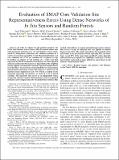| dc.contributor.author | Whitcomb, Jane | |
| dc.contributor.author | Clewley, Daniel | |
| dc.contributor.author | Colliander, Andreas | |
| dc.contributor.author | Cosh, Michael H | |
| dc.contributor.author | Powers, Jarrett | |
| dc.contributor.author | Friesen, Matthew | |
| dc.contributor.author | McNairn, Heather | |
| dc.contributor.author | Berg, Aaron A | |
| dc.contributor.author | Bosch, David D | |
| dc.contributor.author | Coffin, Alisa | |
| dc.contributor.author | Collins, Chandra Holifield | |
| dc.contributor.author | Prueger, John H | |
| dc.contributor.author | Entekhabi, Dara | |
| dc.contributor.author | Moghaddam, Mahta | |
| dc.date.accessioned | 2021-10-07T20:13:11Z | |
| dc.date.available | 2021-10-07T20:13:11Z | |
| dc.date.issued | 2020-10 | |
| dc.identifier.issn | 2151-1535 | |
| dc.identifier.issn | 1939-1404 | |
| dc.identifier.uri | https://hdl.handle.net/1721.1/132787 | |
| dc.description.abstract | © 2008-2012 IEEE. In order to validate its soil moisture products, the NASA Soil Moisture Active Passive (SMAP) mission utilizes sites with permanent networks of in situ soil moisture sensors maintained by independent calibration and validation partners in a variety of ecosystems around the world. Measurements from each core validation site (CVS) are combined in a weighted average to produce an estimate of soil moisture at a 33-km scale that represents the SMAP's radiometer-based retrievals. Since upscaled estimates produced in this manner are dependent on the weighting scheme applied, an independent method of quantifying their biases is needed. Here, we present one such method that uses soil moisture measurements taken from a dense, but temporary, network of soil moisture sensors deployed at each CVS to train a random forests regression expressing soil moisture in terms of a set of spatial variables. The regression then serves as an independent source of upscaled estimates against which permanent network upscaled estimates can be compared in order to calculate bias statistics. This method, which offers a systematic and unified approach to estimate bias across a variety of validation sites, was applied to estimate biases at four CVSs. The results showed that the magnitude of the uncertainty in the permanent network upscaling bias can sometimes exceed 80% of the upper limit on SMAP's entire allowable unbiased root-mean-square error (ubRMSE). Such large CVS bias uncertainties could make it more difficult to assess biases in soil moisture estimates from SMAP. | en_US |
| dc.language.iso | en | |
| dc.publisher | Institute of Electrical and Electronics Engineers (IEEE) | en_US |
| dc.relation.isversionof | 10.1109/JSTARS.2020.3033591 | en_US |
| dc.rights | Creative Commons Attribution 4.0 International license | en_US |
| dc.rights.uri | https://creativecommons.org/licenses/by/4.0/ | en_US |
| dc.source | IEEE | en_US |
| dc.title | Evaluation of SMAP Core Validation Site Representativeness Errors using Dense Networks of in situ Sensors and Random Forests | en_US |
| dc.type | Article | en_US |
| dc.identifier.citation | J. Whitcomb et al., "Evaluation of SMAP Core Validation Site Representativeness Errors Using Dense Networks of In Situ Sensors and Random Forests," in IEEE Journal of Selected Topics in Applied Earth Observations and Remote Sensing, vol. 13, pp. 6457-6472, 2020 | en_US |
| dc.contributor.department | Massachusetts Institute of Technology. Department of Civil and Environmental Engineering | |
| dc.contributor.department | Massachusetts Institute of Technology. Department of Earth, Atmospheric, and Planetary Sciences | |
| dc.relation.journal | Selected Topics in Applied Earth Observations and Remote Sensing, IEEE | en_US |
| dc.eprint.version | Final published version | en_US |
| dc.type.uri | http://purl.org/eprint/type/JournalArticle | en_US |
| eprint.status | http://purl.org/eprint/status/PeerReviewed | en_US |
| dc.date.updated | 2021-10-07T16:11:48Z | |
| dspace.orderedauthors | Whitcomb, J; Clewley, D; Colliander, A; Cosh, MH; Powers, J; Friesen, M; McNairn, H; Berg, AA; Bosch, DD; Coffin, A; Collins, CH; Prueger, JH; Entekhabi, D; Moghaddam, M | en_US |
| dspace.date.submission | 2021-10-07T16:11:51Z | |
| mit.journal.volume | 13 | en_US |
| mit.license | PUBLISHER_CC | |
| mit.metadata.status | Authority Work Needed | en_US |
